Oh, this film.
This film.
Wait. I can do this. I can put together a reasonable, thoughtful blog post on Walt Disney’s Bambi without interrupting the post every few paragraphs with a KILL THUMPER ALREADY, right? I can put aside my feelings about the jarring pacing and tone of the film and the supposedly romantic twitterpating stuff and write some lovely, touching (KILL THUMPER) words about what even I have to admit is a lovely ice scene involving a bunny and an adorable deer on ice, and comment on the great forest fire bit (KILL THUMPER) and put the film into its historic context, with a few words comparing the film to the book. I can do this. I can.
I think.
Walt Disney found himself in a bit of a mess when developing Bambi. His studio was still reeling over the high costs of producing Pinocchio and Fantasia, and the closure of the European film market after Hitler’s invasion of Poland. (In this context, it is perhaps not surprising that Disney insisted on continuing to adapt the anti-fascist, banned-by-Nazis book next, even while assigning animators to the cheaper Dumbo midway through production.) And those were just the external factors. Internally, he had the issue of developing a serious and frankly depressing book into a “Disney” feature, which, to his audience, meant at least some comedy. Oh, Snow White and Pinocchio had their serious moments, certainly, but they had also retained comedic scenes.
And he had the issue of asking his animators to draw animal characters that—because portions of the film would be dealing with serious themes of hunting and death—had look, not like cartoons, but realistic. The Disney animators had managed this more or less in portions of Snow White and Pinocchio, but in both cases, the animators had also put the animals into unrealistic—for animals—situations: housecleaning, smoking, trying to escape evil people who have turned them into donkeys, that sort of thing. The animals in Bambi would be living in a forest and suffering from hunger, just like very real forest animals. It was a new artistic challenge for the animators.
Since the full extent of the Pinocchio financial disaster wasn’t quite apparent at the start of production on Bambi, Walt Disney handled some of these problems the same way he had solved technical problems on Snow White and Pinocchio—by throwing money at them. Lots of money. He sent a photographer to Maine to take pictures of cute forest animals; he brought animals to the studio so that animators could look at actual jumping rabbits, and sent tired animators out to the zoo yet again. Costs leapt up.
The real financial disaster of Bambi, however, turned out not to be live animals, but production speed: animators could churn out about one tenth the number of drawings per day that they had managed for Pinocchio—itself a film with comparatively slow production. To put this in hard numbers: Bambi animators typically created eight to ten drawings per day; Dumbo animators, working at the same time, and free to create cartoon animals not particularly bound by reality or gravity, managed around 120 to 140.
And the real problem with Bambi, as it turned out (BESIDES THE NEED TO KILL THUMPER) was not creating realistic animals and backgrounds, but rather, hinted at right in the title of the book: Bambi: A Life in the Woods. Because the novel is just that: a life. Not what Disney needed: a plot.
Granted, Disney’s films had been relatively episodic in nature. But both were unified by an overreaching plot or theme: with Snow White, escaping the evil queen and marrying Prince Charming; with Pinocchio, becoming a Real Boy; and with Fantasia, creating visuals for music. Bambi: A Life in the Woods has none of that: it’s a work that follows Bambi from year to year, philosophizing about violence and death along the way, but without a central goal beyond survival, or an overwhelming plot beyond the ever present menace of the hunters. And, of course, a high death count.
Snow White and Pinocchio, of course, also had deeply problematic elements and a significant amount of death and violence, so the idea was not, on the face of it, impossible. But the comedy scenes deemed necessary for popular appeal, which had effortlessly flowed in Pinocchio and at least sorta worked in Snow White, proved more difficult with Bambi. Some scenes transitioned well—the dark greys and blues of the opening sequence shifting to the brighter, happier moments of Bambi’s birth.
Others did not. Arguably the worst: the death of Bambi’s mother in the snow—a gripping, emotional sequence that left many small children scarred for life—which is immediately and jarringly followed by a colorful scene of cheerful birds singing about spring. I am entirely on the side of the owl loudly and angrily objecting to all of this, but also, emotionally spinning. An argument could be made, I suppose, that the audience desperately needs something to follow that scene, but not, I would say, that moment. The forced comedy and cheer robs the film of a moment to breathe, and to mourn, and it feels all wrong.
Not quite as wrong, granted, as the scene that follows, when Flower, Thumper, and Bambi all fall in love, just moments after assuring the viewers that they won’t, but wrong.
Speaking of the falling in love stuff, the worst part of that is not, I must say, the misogyny, or the part where Bambi and Rollo fight over Faline. The animation of that is fascinating, as the already softened backgrounds slide away still further, leaving Bambi and Rollo often fighting against colors, and it serves as a nice enough setup for Bambi and Faline’s later relationship. Nor is it the brief moment when Flower meets the love of his life and they trot over to live in the flowers, although that’s not really great either.
It’s, sigh, Thumper’s part.
Here, the animators abruptly dropped the realistic animation used in most of the rest of the film and instead had his lady rabbit vamp out in front of him and seduce him away from Bambi, right down to using sexy poses and long fluttering lashes. I cringed. In another animated film, this would work quite well (mild misogyny aside). In this film, which contains realistic scenes of hunting and starvation, jarring is not quite the word for this cartoon sequence that feels completely out of place.
And since I’ve brought Thumper up:
I know, I know.
Yes, yes, Thumper has his adorable moment of grammatically destroying his father’s command of “If you can’t say anything nice, don’t say nothing at all,” and he doesn’t want to eat his greens aww and he goes ice skating with Bambi how sweet and he grates on me. Oh, how he grates.
For the record, it’s not that I don’t like adorable bunnies. I love them. Thumper’s little brother and sister bunnies? Adorable. Love them. Thumper? No. Also, not that adorable. It’s partly the voice, but mostly the character, who is frequently obnoxious and superior, and often seems to belong to an entirely different film. Thumper’s scenes, after all, are generally played for comedy, in a film where most of the other animals are dealing with the serious notes of hunger and death and fear and hunting in the rest of the film. But beyond that, Thumper is also animated in a looser, more cartoon like style, instead of the realistic approach used for other animals in the film. His ice skating scenes, for example, were patterned on the movements of human ice skaters, not actual rabbits sliding on ice—which is standard for many animated films, granted, but out of place for a film like this which otherwise sticks to having its animals move as realistically as possible.
Thumper, I should note, is not in the original novel, and was added to the film because Walt Disney thought they could have a lot of comedy and fun with a rabbit. Their rival studio Warner Bros would prove them right on this, of course, but while Bugs Bunny is one of my all time favorites, I spent this film hoping that the forest fire would burn Thumper to the ground.
Possibly not the reaction Disney wanted from viewers of this film.
Having said all that, in one sense Thumper does fit in well with other, crueler sections of the film. In scenes where others praise and nearly worship Bambi (for instance,the birth scene, something that would be redone, rather better, by The Lion King decades later), Thumper mocks the little deer, and is often cruel. This has the immediate advantage of turning Bambi into the underdog, someone viewers can sympathize with and root for, and it also works with the rest of the film, with its undercurrents of cruelty and pain.
That function, however, is undercut by another very real problem with Thumper: he, more than any other character in the film, is trying to get Bambi to do very human things like ice skating—thus copying the very people trying to kill him.
And watching that right after reading the book made me shudder.
I know what happened to the animals in the book who did try to be more human, who did work with humans, who did allow the humans to turn them into pets.
It did not go well.
So a film that on the one hand contains lovely little nods to elements within the book (for example, the scene where two leaves fall from a tree, in a homage to the chapter in the novel where those two leaves discuss life and death), but on the other hand contains scenes where Thumper, without irony, attempts to make Bambi more human, strikes a deeply discordant note.
The animators did better with Bambi, who grows from a timid, cowardly, and, if we are to be honest, rather annoying little deer (he is very young) to a bold deer capable of fighting off dogs in order to save Faline, right before they have to flee a forest fire. I am a bit dubious that Bambi would be capable of fighting off a single dog, let alone a pack of dogs, but that scene, plus the earlier hunting moments, and the forest fire, provide the most visually interesting parts of the film, so I guess I can let it slide.
I’m less inclined to let a few other things slide: the forgettable songs (not a single “Whistle While You Work” here, let alone a “When You Wish Upon a Star,”), the jarring emotional changes, and the problem that the parts of this film not involving hunters or fire are often incredibly slow. Bluntly put, much of Bambi might be beautiful, but with the exceptions of the twin scenes with the hunters, it’s also boring.
That is, until the forest fire, a gloriously animated, terrifying sequence, as the animals flee from a terrible fire accidentally set by the hunters. (This scene is not in the book, and was reportedly inspired by accounts of major wildfires in the American west in the 1930s.) It’s astonishing, gripping, and for me deeply frustrating, since it—and other gloriously animated moments—show what Bambi could have been.
Those gloriously animated moments include the rainstorm, the forest fire, the two leaves falling from a tree (a quiet and welcome nod to the book), a snowstorm (animated with the help of cornflakes), and, well, the two hunting scenes. But they’re not enough to make up for the rest of the film, even with a remote control on hand.
I can’t leave the post, I guess, without talking about one of those two hunting scenes—the death of Bambi’s mother. It works, I think, in part because so much of the rest of the film is so slow, so boring, so beautiful, so cute. Death permeates the book; it does not permeate the film, which contains only two deaths—Bambi’s mother and a partridge. Death is so inevitable in the book that it is never a shock. Even knowing that it’s coming, it’s a shock in this film. It doesn’t help that I totally forgot the film has two hunting scenes—and Bambi’s mother does survive the first one. And that in the film, we can see little Bambi, who has never been presented as very intelligent, or very knowledgeable, all alone in the snow, hearing that his mother will never come back.
No wonder so many small children, seeing this, were scarred for life.
It’s powerful, certainly.
Beautifully animated, certainly.
You’re all probably better off watching Bambi Meets Godzilla.
Initial earnings for Bambi were a disappointment, and that was only the beginning of the bad news. As final production inched along in 1941, the Disney animators went on strike; the Japanese bombed Pearl Harbor; and the United States entered a lengthy, two front war. The brand new Walt Disney Studios, built to accommodate the ever growing artistic staff, was commandeered by the United States Army. Bambi turned out to be the latest in a string of financial losses for the studio. It was a disastrous period for Disney—what Roy Disney would later call the “lost years.”
As a result, Disney abandoned the idea of full length, lavishly animated films, instead producing cheap anthology films featuring various animated shorts. We are going to skip most of these, with the exception of the final one in the group: The Adventures of Ichabod and Mr. Toad.
Mari Ness lives in central Florida.










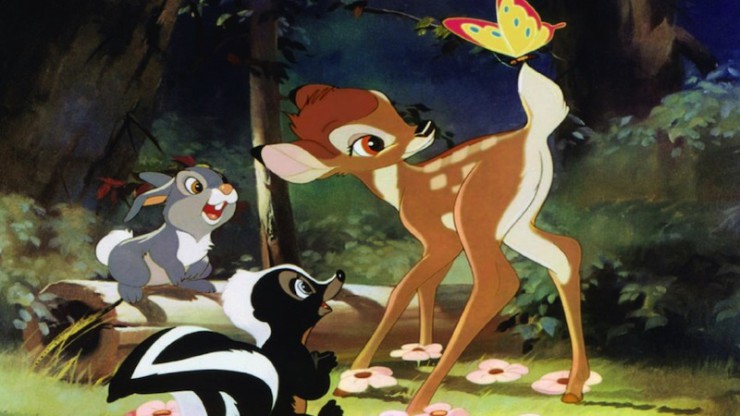
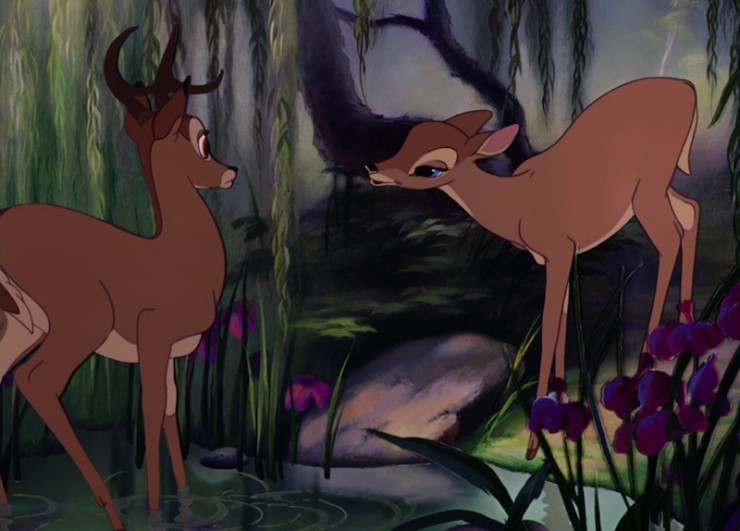
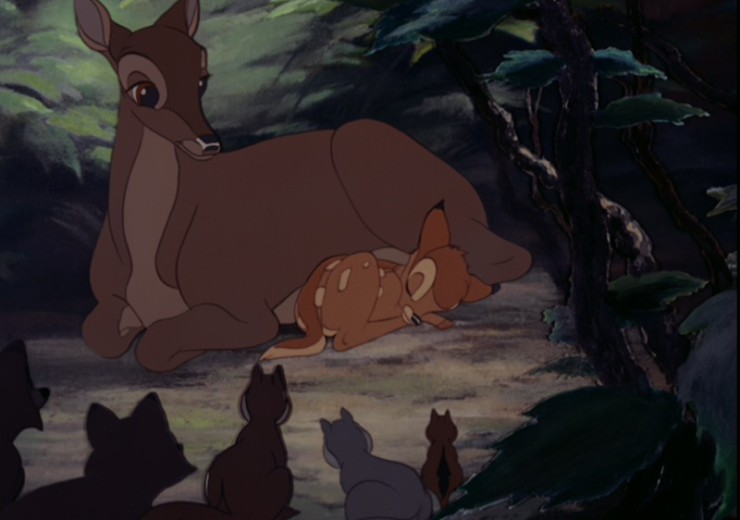
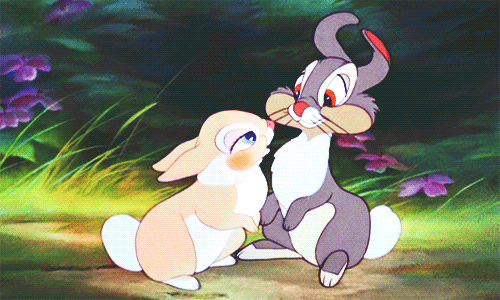

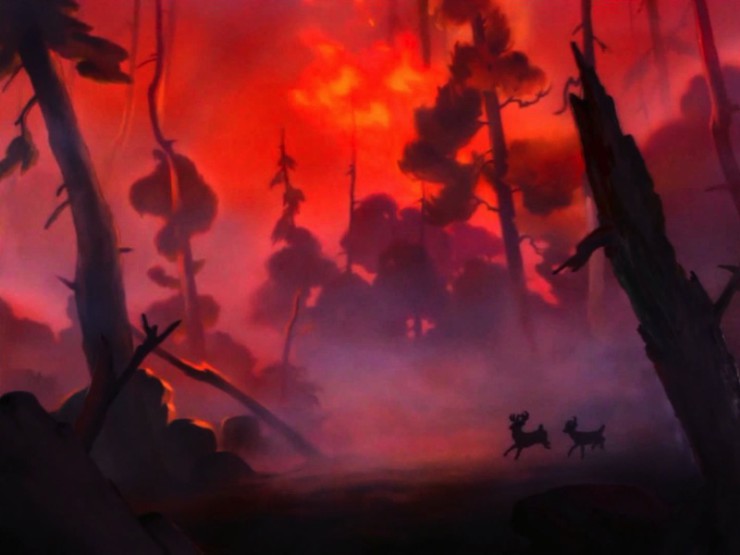
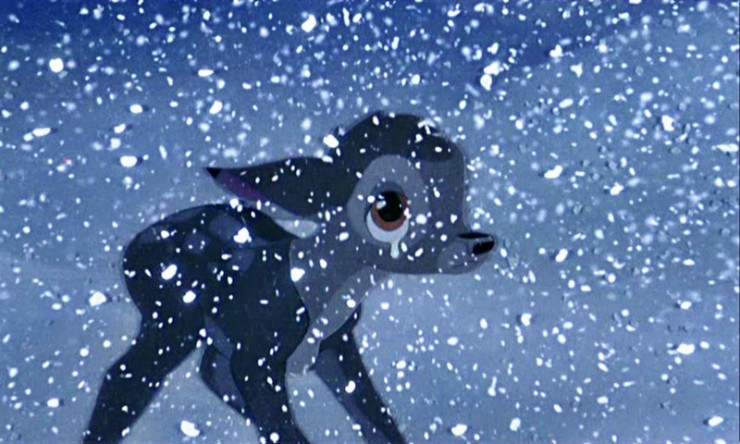
For me the music was anything but forgettable. I still enjoy it. But good take on the rest of the movie. The “twitterpated” sequences were only slightly amusing to one who turned out to be immune, and I can’t get worked up over a prey species…
WTF tor.com? Another one of my comments was eaten (and comments keep appearing and disappearing from other users). Also, this comment box is ridiculously slow for typing in.
I was not expecting this review! I’ll admit it, Bambi is not my favorite Disney movie, and I didn’t see it as a child so I don’t have any particularly intense memories. But I still think it’s a lovely story about growing up, coming of age, love, loss, seasons, etc. The music isn’t high on the list, but I love the Raindrops song and Love is a Song is nice too.
I was not expecting the Thumper reaction though! I always thought he was kind of cute. Unless there’s a line I’m forgetting, I don’t know that the ice skating is meant to ingratiate themselves to humans, or even imitate them. Maybe they just like it ;) I am overthinking things!
The twitterpated sequences are kind of silly/old fashioned, but they don’t rate too highly on my misogyny/annoyance meter.
The stag always kind of did though! And then Bambi just running off with him…although I suppose that’s meant to be ‘natural’ (and I get what you are saying that there is a dissonance between the cartoony aspects and the more realistic ones).
Maybe this comment will save!
I can’t see the link to the previous post in the series on here. I don’t know if it has to do with the new site, because it’s showing up on another post.
After doing some wiki research, the love song I was actually thinking of was ‘Looking for Romance’ (the one that plays while Bambi and Faline fall in love). I like the melody (although I couldn’t tell you any of the lyrics). Love Is a Song is the opening credits song.
Never actually seen Bambi. Just clips.
Relentless, sexual female animals determine to mate with a minor male animal are — or were — a staple of Disney animated films. See, for instance the girl squirrel in The Sword in the Stone. Hate that.
The Bambi novels however among my most favorite books growing up, and I re-read them often well into my adult years. They are still on my shelves, but I’ve re-read them so often I no longer do.
I just went to pick up Salten’s book for my Kindle. I found another ‘Bambi’ as well- this one a novel from 1914, and pretty entertaining.
@Lisamarie,
I’ve always been fond of “Looking for Romance” as well, but it’s hard to argue that it’s a really good song on the lines of “Whistle While You Work” or “Wish Upon a Star.” It’s not particularly catchy, and the lyrics are rather awkward. The Disney “Story on tape” I had as a kid didn’t even include it, substituting “Love is a Song” (which I don’t care for) in that same spot.
All in all, I think it works as part of the score to accompany that part of the movie, but it’s not a song that could ever stand on its own the way most of the great Disney music can.
Bambi is the first movie I remember seeing in a theater…as a double-feature with Old Yeller.
Someone at Disney really hated children.
I don’t remember being overly offended by Thumper, but I also saw Bambi when I was really young. I also had no idea the movie was based on a book, so having no comparison there Thumper’s “let’s ice skate” and other human-esque scenes didn’t annoy me as they did you.
Otherwise I mostly agree with the review–I know I’ve seen this movie, as a kid and a couple times since, but damned if I can remember anything about it other than the fire scene. I honestly don’t even remember his mother’s death scene–I remember the sad part about it, sure, but not the scene itself until I’m reminded.
And there was music in this movie? Like, with words and stuff? Coulda fooled me.
Rewatching it as an adult, I find Thumper et al. laughing at Bambi learning to walk, quite offensive; laughing at anyone who is doing their best is vile. In the ice-skating scene, Disney seemed determined to hammer it in that Bambi is just a klutz. But the scenery was wonderful, far more than any of the characters. As to the music, I liked the April shower song and most of the instrumentals.
I don’t recall much about the book.
What? No mention of the stealth deer? The greatest part of the movie is when the next generation of deer are clearly born with cloaking technology in their DNA (or someone forgot to color the baby deer).
Actually, after having weeping hysterics as a kindergartner when Mom read me the Golden Book version of Bambi, I blew all chances of ever seeing the movie till I was old enough to have my own DVD player. Still haven’t gotten around to it. So, I can only comment on clips–and the weeping hysterics when Bambi’s mother dies.
As an uncoordinated kid who never did learn to ice skate, I completely sympathize with Bambi. As for Thumper, notice how his body mass is swung low and more widely distributed than Bambi’s. Plus, he’s got wide, furry feet while Bambi’s perched on narrow, slippery hooves. Of course, Thumper has an easier time of it.
I have two ways of seeing Bambi and Faline. One is that, duh, male deer fight over females. Seriously, who doesn’t know this? The other is that family relationships are the most heavily anthropomorphized element of Bambi. The Prince of the Forest may not be around much, but he’s far more involved with Bambi than a normal stag would be. Relationships are monogamous and long-lasting, no matter what the norms of the animal species in question. It does confuse the message (and I’m still not sure what that message is).
The female rabbit is a bit simpler since, had Thumper behaved this way, showing up out of the blue and being quite convinced of his ability to seduce a female without any conversation, I’d be looking into the anthropomorphic version of a restraining order.
I’ve always considered Bambi a flawed masterpiece.
As far as Thumper being kind of a jerk goes, what about at the beginning where Bambi’s mom tells him her child’s name, and he says something like, “Yeah, I guess that will do”? Because it’s the job of some random rabbit to approve names?
The mix of anthropomorphism and realistic animal behavior does make for some weirdness. Bambi usually opts for the latter, but with enough of the former to make scenes where the animals DO behave like animals (Bambi fighting over Faline and the aloofness of the stags, for instance) a bit jarring. Also, we never do find out what that owl actually eats, and he seems to be friends with creatures that would typically be his prey.
Apparently Thumper’s mate is really popular in Japan, and she’s known as Miss Bunny.
An article about Tyrus Wong, who did visual development of the backgrounds for this movie, inspired by Song-dynasty landscape paintings (more detail in his obituary).